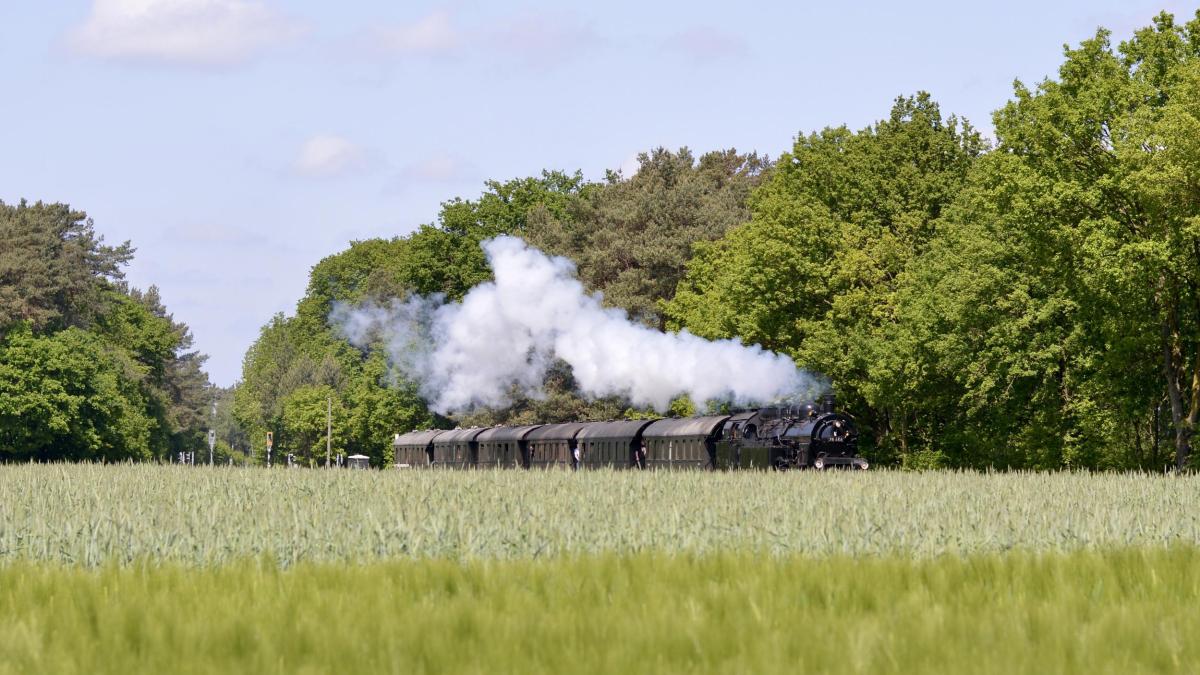ZWhite vapor rises between beech, oak and pine trees. A pounding staccato gets louder, a piercing whistle sounds. A puffing steam locomotive emerges from the forest. Red rods drive the spoked wheels, dark green wagons rattle by, passengers wave from open windows.
On certain days, the Teuto-Express commutes between Bielefeld and Halle/Westphalia at the foot of the Teutoburg Forest. Among the passengers are train lovers, grandparents with grandchildren and day trippers who want to experience something special. Traveling by train using steam has become a rarity – it’s been a long time since 1835 in Germany, when the first steam locomotive drove from Nuremberg to Fürth.
Long since replaced by diesel and electric locomotives, around 100 steam locomotives are now on the road nationwide, as tourist trains or as museum trains, operated by clubs. Just like the Förderverein Eisenbahn-Tradition e. V., which maintains the Teuto-Express as a museum fleet in the Lengerich marshalling yard: with a number of steam and diesel locomotives as well as freight and passenger wagons from the years 1920 to 1950. They travel on the regular DB routes of the Tecklenburger, Münster – and Osnabrücker Landes – once a year on longer trips of up to 400 kilometers.
“Our train is a living museum”
Like in grandmother’s day, the passengers sit in the carriages on the wooden bench in the third carriage class or pay an extra charge for upholstered seats. The cars from the 1920s were then called “blunderbusses” – rightly so, the driving noise is loud and booming. There are still ancient rotating soap dispensers on the train toilet, and a bistro is housed in one of the carriages.
“Klärchen is in a good mood today,” says steam engine driver Michaela Quante, 47. She drives for the association on a voluntary basis, as do stoker Jannik Mählmann, 26, and pilot Inga Börger, 53 – all three are there both in their free time and in their professional lives connected to the train. The Klarchen steam locomotive is the only steam locomotive of the class 78 (Prussian T18) that is still operational, the serial number is 468. The colossus weighs 105 tons, has 1140 hp and is exactly 100 years old.
Almost imperceptibly, the locomotive starts to move, rolling more gently than expected. After a few meters, it shows its strength, the pistons rotate in the cylinder, fire and water send around 220 passengers on a journey through time that day. “Our train is a living museum,” says Heizer Mählmann. Train driver Quante agrees: “Our children only experience technology that works at the push of a button or not. A steam engine, on the other hand, can be continuously adjusted between zero and 100 percent. It is technology that you see, smell, hear and feel.”
Country air flows through the open windows into the driver’s cab and mixes with the smell of oil and coal. It’s too loud for conversation. Hand signals must suffice. Michaela Quante opens the fire door with her left hand and the stoker shovels the charcoal into the flames. Outside, the landscape flies by. Drivers get out at level crossings and hold up their smartphones. “Everyone is happy to see us,” says Mählmann.
At Bielefeld Central Station, the dispatcher waves from his tower. “Three lengths, two more, one more engine length – now you can stop,” the stoker directs his engine driver. A little boy stands next to the locomotive and calls up to Michaela Quant: “Where are you going now?” In the ICE on the neighboring platform, many passengers press their noses against the window.
Climate, coal and costs are problems
The T18 manages 100 kilometers per hour, forwards and backwards. But the steam locomotives are counted. The climate, coal and costs are their problems – although the steam enthusiasts put the climate issue into perspective: the Association of German Museum and Tourist Railways (VDMT) estimates the consumption of a steam locomotive to average around 1.5 tons of coal per 100 kilometers.
Applied to 360 passengers per train, this results in CO₂ emissions of 117.9 grams per passenger kilometer. According to the VDMT, a diesel car emits 121.5 grams per kilometer. “And every amusement park uses more energy, and every art museum also has to heat its rooms,” adds the engine driver.
A ton of coal now costs around 900 euros. Good quality lump coal is becoming increasingly difficult to obtain. The Teuto-Express-Verein places orders in Poland, among other places. Some of the increased coal prices are passed on to the tickets – the daily commute ticket between Halle/Westphalia and Bielefeld costs 25 euros. “If we didn’t have the numerous donors, we wouldn’t be able to keep up the business,” says Michaela Quante.
After all, alternatives to coal are being experimented with. In Emsland, for example, the “Niedersachsen” steam locomotive is already in its second season on the road with wood pellets. “This is a sustainable fuel that is attractive in terms of price and environmental protection,” says Maik Drechsel from the engineering firm Steam Technologies, who is accompanying the experiment. But there are challenges: “Because of the lower energy content, it has to be recharged more frequently.”
In addition, in the case of large locomotives, it is necessary to convert the pellets automatically. According to Drechsel, so-called biochar would also be conceivable, which would be produced sustainably using a thermal-chemical conversion process. There are corresponding tests in England, but: “There is still no such product that was really convincing.”
Visitors can drive the steam locomotive themselves
Drechsel mentions another problem: A uniform train safety system is to be introduced in Europe in the long term. As soon as the ETCS (European Train Control System) comes into force in Germany, the old locomotives would have to be converted at a cost of several hundred thousand euros. “Fortunately, that will take some time,” believes the engineer.
It’s best to get on board while the locomotives are still steaming. And what could be nicer than a ride as a passenger in the Teuto Express carriage? Exactly: A ride directly in the locomotive, with the option of even controlling it yourself. Twice a year there is such a “steam locomotive seminar” in Lengerich, including studying technology, shoveling coal, polishing the boiler.
Everything is fully booked this year, the next dates are in the calendar for spring and summer 2024. The highlight: lift the regulator in the driver’s cab and set the locomotive in motion – at least for a few meters in the marshalling yard. Long enough to really let off steam.
Journeys with the Teuto Express:
With around 60 members, the Eisenbahn-Tradition association maintains historic steam and diesel trains as the Teuto Express, including three steam locomotives. Visitors and helpers are welcome every Saturday from 10 a.m. at the marshalling yard at Lienener Straße 100 in Lengerich-Hohne.
The next trips: On August 6th and September 24th (on Sundays) shuttle trips are planned from the home station Lengerich-Hohne (departure 10am, 1.30pm, 4.30pm) via Lienen and Bad Iburg to Bad Laer and back. The shuttle ride costs twelve euros for adults (there and back), the day ticket 20 euros. For August 20th there are shuttle trips between Ibbenbüren-Aasee (departure 10.30 a.m., 1.00 p.m., 3.30 p.m.) and Dörenthe-Kanalhafen in the timetable; Round trip 14 euros; there are reduced tickets for children. If you want to drive on upholstered seats instead of on wooden benches, you pay a surcharge of five euros. In December, the Nikolausexpress runs on three weekends on various routes in Münsterland, East Westphalia and Lower Saxony (duration up to three hours).
At risk of forest fires is not driven with steam but with diesel locomotives in summer.
Ticket Reservation at eisenbahn-tradition.de
Three other historic railways in Germany:
With Molli on the Baltic Sea through Mecklenburg
In summer, the “Molli” commutes every hour between Bad Doberan and Kuehlungsborn, in winter every two hours. The scenic route along the Baltic Sea was opened in 1886. Two steam locomotives from the 9923 series, built in 1932, are in use, specially designed for narrow 900 millimeter rails. Nine stops and four listed station buildings are spread over 15 kilometers.
In summer, the narrow-gauge railway, officially called the Mecklenburg Baths Railway Molli, departs from Kuehlungsborn West at 6.40 a.m.: First it goes through the village, then on through fields and forests. In the middle of the route, the locomotive stops at the seaside resort of Heiligendamm with its “white town by the sea”, then the train with its lovingly restored wagons rattles to Bad Doberan, where it rumbles like a tram across the main street.
For 60 euros you can even ride in the front of the locomotive. If you want to know more, visit the Molli Museum in Kuehlungsborn West. A single ticket for all three zones costs 11.50 euros. On the train, the Germany ticket is valid with a narrow-gauge railway surcharge of eight euros for the day ticket (molli-bahn.de).
Drive through Franconian Switzerland
Not far from Germany’s first railway line from Nuremberg to Fürth (1835), the Fränkische Schweiz Dampfbahn association has been involved in its museum railway since 1980. It runs regularly on Sundays and public holidays between Ebermannstadt and Behringersmühle. The journey through the picturesque valley of the Wiesent, past karst rocks and half-timbered houses, takes 45 minutes.
On steam operating days, usually twice a month, a Hanomag locomotive (built in 1923) or locomotive 64 491 built by Orenstein & Koppel in Berlin in 1940 are in use. Bicycles can be accommodated in the baggage car. Hiking shoes are a smart choice, because from train stations like Muggendorf or Gößweinstein you can walk to stalactite caves like the Bing cave or castles like the Neideck castle ruins. Tickets for a round trip cost 17 euros, in the upholstered class 24 euros (dampfbahn.net).
The Kandertalbahn in the Black Forest
In the summer, the Kandertalbahn runs in the southwest on Sundays in Markgräflerland. The historic museum train is operated jointly by the Kandertalbahn Association and the Kandertalbahn Zweckverband. If the weather cooperates, the locomotive 20 (built in 1928) or the robust locomotive 30 (from 1904) steam ahead from May to October. The latter, the “Prussian T3”, has been the main draft horse of the Kandertalbahn since 1969. Its nickname in the Alemannic dialect is “Chanderli”.
On the route between the pottery town of Kandern and stations such as Wollbach, Wittlingen or Binzen to Haltlingen, passengers experience a typical Black Forest branch line for a good half hour over 13 kilometers. Haltingen is known for its wine, such as Gutedel from the Haltinger Stiege. From the train station it is not far to the four-kilometre-long circular route over the vineyards on the Tüllinger Berg. The return ticket is available for 16 euros (kandertalbahn.com).




